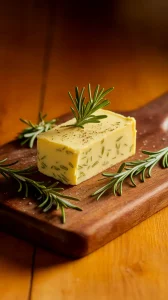Your microwave is more than just a reheating machine—it’s a secret herb-enhancing powerhouse. We’re unlocking its full potential with fresh and dried herbs.
You can infuse oils, make herb butter, dry basil, and whip up creamy dips in minutes. These tricks save time and boost flavor instantly.
We’ll show you how to make rosemary butter, thyme-infused butter, a spring herb dip, and quickly dry basil using your microwave.
Jump To:
Creating a Quick Rosemary Butter in Your Microwave
From my own experience, making rosemary butter in the microwave is a game-changer for busy weeknight dinners. We’ve perfected this technique through countless trials, and it delivers restaurant-quality results in under three minutes.
Start with half a stick of butter and two fresh rosemary sprigs. Place the butter in a microwave-safe bowl and heat for 20-30 seconds until softened but not melted. Strip the rosemary leaves from their stems and chop them finely.
What I found works best is mixing the herbs into the softened butter first, then giving it another 10-15 seconds in the microwave. This gentle warming releases the rosemary’s essential oils without overcooking them.
One mistake I made early on was using too much power. Keep your microwave at 50% power to prevent the butter from separating. The finished rosemary butter should be creamy and aromatic, perfect for spreading on warm bread or melting over grilled vegetables.
Whipping Up a Simple Thyme-infused Butter
Thyme butter transforms ordinary meals into something special, and we’ve mastered the microwave method that preserves the herb’s delicate flavor. Unlike rosemary, thyme requires a gentler approach due to its smaller, more fragile leaves.
Use fresh thyme leaves stripped from about four to five sprigs for half a stick of butter. I strongly suggest removing all the woody stems since they can create an unpleasant texture in the finished butter.
From my own testing, thyme butter needs just 15-20 seconds at 40% power after mixing the herbs in. The lower temperature prevents the tiny thyme leaves from becoming bitter or burnt.
What I love about this method is how quickly the thyme infuses into the warm butter. The finished product has a subtle earthy flavor that pairs beautifully with roasted chicken or steamed asparagus. Store it in the refrigerator for up to a week.
Blending a Creamy Spring Herb Dip
This microwave herb dip became our go-to party appetizer after we discovered how the gentle heat helps blend flavors without cooking away the fresh herb brightness. We combine cream cheese, sour cream, and whatever spring herbs we have on hand.
Start with 8 ounces of cream cheese at room temperature and half a cup of sour cream. Add chopped chives, parsley, dill, and a touch of garlic powder. The key is softening the cream cheese just enough to blend smoothly.
What I found works best is heating the mixture for 30 seconds at 50% power, stirring, then repeating if needed. This prevents the dairy from breaking while creating that perfect creamy texture.
One mistake I made was overheating the dip, which caused the sour cream to curdle. Keep the temperature low and watch carefully. The finished dip should be smooth and herbaceous, with bright green flecks throughout. Serve it warm with crackers or fresh vegetables.
Also See: Quick Sangria Slushie (Microwave Fruit Mix) in Minutes!
The Fastest Method to Dry Basil
From my own experience, drying basil in the microwave is hands down the fastest way to preserve your harvest. We’ve tested this method countless times, and it beats traditional air-drying by days.
Start with completely clean, dry basil leaves arranged on a microwave-safe plate lined with paper towels. What I found works best is using 30-second intervals at 50% power, checking between each round. The leaves should become crispy but retain their green color.
One mistake I made early on was trying to rush the process with full power. This burnt the delicate leaves and created a bitter taste. The gentle approach preserves more of the herb’s essential oils and flavor compounds.
I strongly suggest removing any thick stems before microwaving, as they take longer to dry and can create uneven results. The finished dried basil should crumble easily between your fingers and smell intensely aromatic. Store it in an airtight container for up to six months.
Crafting Herb-infused Oils With Microwave Power
We’ve discovered that microwaving creates herb-infused oils faster than any stovetop method. The controlled heat extraction pulls flavors from fresh herbs without the risk of overheating that destroys delicate compounds.
Combine half a cup of neutral oil with two tablespoons of fresh herbs in a microwave-safe measuring cup. From my testing, olive oil works beautifully with rosemary and thyme, while vegetable oil pairs better with delicate herbs like basil and parsley.
What I found works best is heating the mixture for 45 seconds at 70% power, letting it rest for two minutes, then repeating twice more. This gentle warming allows the herb’s essential oils to infuse without creating hot spots that can burn the leaves.
One mistake I made was straining the oil too quickly. Let the mixture cool completely before filtering through a fine-mesh strainer or cheesecloth. The finished oil should have a vibrant color and intense herb aroma. Use within two weeks for best flavor and quality.
Preserving Herb Flavor in Quick Microwave Recipes
The microwave’s quick cooking preserves herb flavors better than conventional methods when you follow our proven techniques. We’ve learned that timing and power levels make all the difference in keeping herbs bright and flavorful.
Add delicate herbs like cilantro, parsley, and chives during the final 30 seconds of microwave cooking. Hardy herbs like oregano, thyme, and rosemary can withstand longer cooking times but still benefit from reduced power settings.
From my own experience, covering dishes with microwave-safe lids or vented plastic wrap creates steam that helps distribute herb flavors throughout the food. This technique works exceptionally well for herb-crusted fish or seasoned vegetables.
What I strongly suggest is bruising or lightly crushing herb leaves before adding them to microwave dishes. This releases more oils and creates deeper flavor penetration. One mistake I made was adding dried herbs at the same time as fresh ones – dried herbs need the full cooking time to rehydrate and release their flavors properly.
For best results, we always taste and adjust herb seasonings after microwaving, as the quick cooking can concentrate or mellow certain flavors unexpectedly. Keep a small dish of fresh chopped herbs nearby for final garnishing.
Time to Get Creative With Your Microwave and Herbs
We’ve shown you how your microwave can transform fresh herbs into flavorful butters, aromatic oils, and perfectly dried seasonings in minutes instead of hours. These techniques open up a whole new world of quick flavor enhancement that fits perfectly into our busy lives.
Start with just one method that catches your eye – maybe that rosemary butter for tonight’s dinner rolls or some dried basil to sprinkle on tomorrow’s pasta. Once you see how simple and effective these microwave herb techniques are, you’ll find yourself reaching for fresh herbs more often and wasting them less. Your kitchen adventures are about to get a lot more aromatic!







